From The CRPG Addict
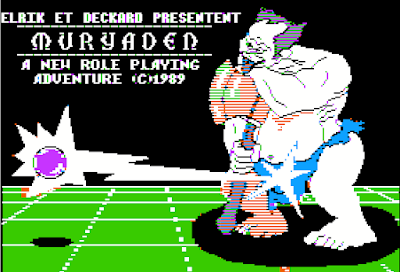 |
| You are not misinterpreting this screen. The troll is having his genitals stimulated by a magic stone. It’s that kind of game. |
Muryaden
France
Elrik et Deckard (developers); Bytlejuice (publisher)
Released in 1989 for Apple II
Date Started: 12 May 2020
Date Ended: 14 May 2020
Total Hours: 5
Difficulty: Moderate (3/5)
Final Rating: (to come later)
Ranking at time of posting: (to come later)
Difficulty: Moderate (3/5)
Final Rating: (to come later)
Ranking at time of posting: (to come later)
At first glance, Muryaden is another Ultima clone, but I guess it was intended as a sort of anti-Ultima. It was made by developers who held at least mild contempt for not only Lord British but the entire history of American RPGs. I get this from a web page that one of the authors used to maintain; I would appreciate if anyone who speaks French fluently would scan this page and let me know if there’s anything in the following account that I got wrong. I can read French, but I’m having trouble with this French, which seems to include a lot of slang and nonstandard uses of words. Do French people really use ricaines as a slur for “Americans”?
Anyway, the chief complaint of Elrik and Deckard seems to be that the American approach to fantasy RPGs was too “clean.” They were less interested in high fantasy of the Tolkien type and more interested in gritty Conan-style sword and sorcery, with attendant sex and gore. In their authors’ desires to ensure that their programs wouldn’t be banned by “austere Puritan traditionalists,” they argued, American RPGs always take place in a “quasi-religious atmosphere” in which a noble purifier “arrives at the right time to deliver the world from a diabolical oppressor.” The plots are interchangeable and the universes are “clean and hygienic,” with no sex, brothels, or even any latrines.
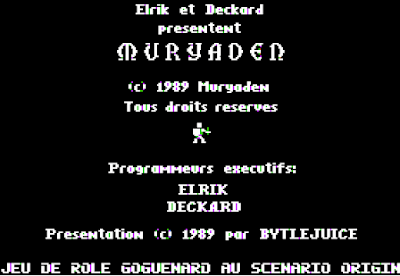 |
| The game is credited to “Elrik” and “Deckard.” |
I think the authors go a bit too far in imputing motive to American RPG developers (and not far enough in appreciating them for, you know, inventing the genre in the first place), but I’ll concede that they have a point. American CRPGs in the 1980s are awfully vanilla. I don’t know that the solution lies in graphic descriptions of demon ejaculate, but at least it gets points for originality.
The backstory for the game thus reads less like someone trailblazing a new era in realism and more like the fruits of the perverse imaginations of two sex-starved young men. I’m going to elide quite a lot, partly to prevent Google from putting an NC-17 warning on my blog, partly because I didn’t always understand the language, and partly because I just found it gross. Some misunderstandings of my previous positions have led to an incorrect “The CRPG Addict has a problem with breasts!” belief, but I have no problem with the perception that I have a problem with graphic description of anal manipulations with tentacles. That belief is 100% accurate.
The story begins when a sorcerer named Mithgul moved into the middle of a fairly generic fantasy kingdom. He holed himself up in his fortress and got to work on various inventions and experiments, almost all of a sexual nature. He created a “stone of beauty,” an artifact that endowed its holder with “unlimited charisma,” such that he could drive a crowd of people to mass suicide. He mated humans with demons and beasts to produce all kinds of abominations. He collected fluid samples from dozens of species and invented a number of creative aphrodisiacs.
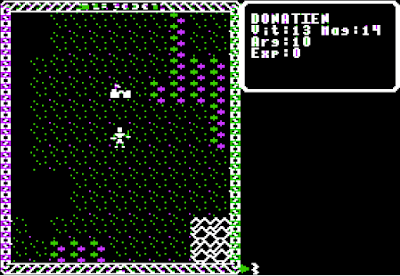 |
| The game is at first visually indistinguishable from one of the Ultimas. |
Mithgul’s efforts came to an end when the seed of a demon mixed with some other chemicals and caused an explosion that destroyed Mithgul’s tower. Unfortunately, the escaping vapors engulfed the nearby town of Bar-Calenlad and turned the entire population into nymphomaniacs, leading to massive population growth. A local order of paladins didn’t have any hope of maintaining their chastity vows, and soon their fortress had expanded enough in population to form a new city, Bar-Tolainor. Trolls escaping from Mithgul’s dungeon formed their own city, Echorkeliant. Generations later, each city has developed its own sado-sexual traditions. Lately, a villain named Beltrik the Skatomancer has re-inhabited the ruins of the fortress. He’s kidnapped the daughter of King Valdrin and caused such strife among the trolls that they’ve split into two factions. Into this milieu, the character is dropped without an explicit quest yet.
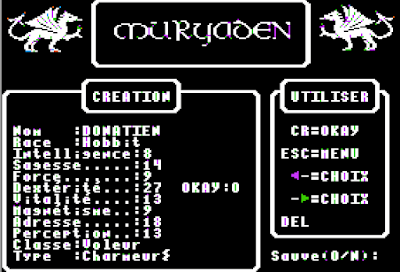 |
| Character creation. |
Character creation doesn’t break much new ground. You assign a name and race (human, elf, dwarf, hobbit), after which the game randomly rolls for wisdom, strength, dexterity, and intelligence, modified by race. These four attributes together determine the derived statistics of vitality, charisma, skill, and perception. Your choice of class (sorcerer, priest, warrior, thief) has further effects on these statistics, and finally you can specify a “type” (charmer, skillful, attentive, resistant) that makes further modifications.
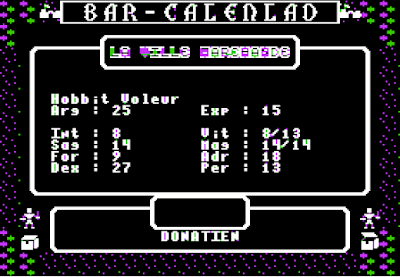 |
| My early-game character sheet. |
The game begins with the character standing on the plains outside Bar-Calenlad. The game world is a small 58 x 58, but it seems larger because of frequent random encounters. There are the three cities mentioned in the backstory plus a few dungeons and Castle Gondarnost. The interface follows Ultima‘s tradition of mapping commands to individual keys, such as C)hercher (search), O)uvrir (open), and P)énétrer (enter, as in a city).
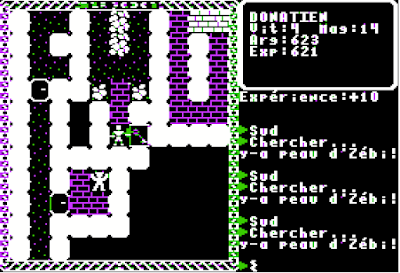 |
| Can someone tell me what the phrase y-a peau d’Zébi means? |
Enemies mostly include fantasy standards like orcs, trolls, bandits, mercenaries, zombies, kobolds, and giant spiders and snakes. They’re not seen in the environment until they attack. Combat is a little more complex than Ultima but not quite as complex as, say, Wizardry. You face only one enemy at a time, and you have options to fight, change weapons, cast a spell, use an object, advance, back off, surrender, or steal. “Advance” and “back off” are unusual commands, but there’s a distance consideration in combat, with enemies and characters occupying four potential spaces from très proche (very close) to très loin (very far). Certain weapons work better (or don’t work at all) at various distances.
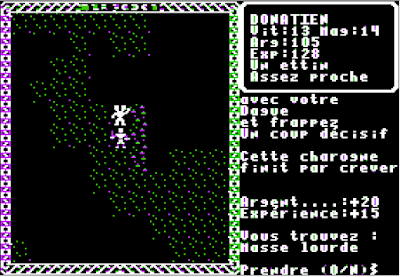 |
| Fighting an ettin from “close enough.” |
The cities are menu cities that offer various options depending on the city. Bar-Calenlad offers an inn, a Temple of Eros, a guild, an alchemist, a weapon/armor shop, and a fence. Early on, I didn’t understand the options for the other places, so I just bought a dagger and robe (the only items my strength would let me wield) and headed out to fight.
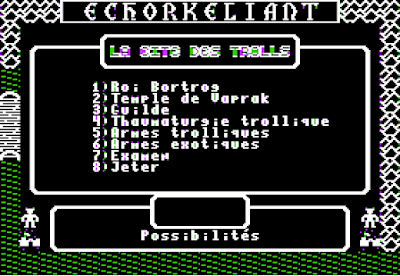 |
| Menu options in the troll city of Echorkeliant. |
It took me a lot of deaths (fortunately, reloading is quick) before I realized the importance of getting physically close to the enemy when all you have is a dagger. The good news is that when you’re that close, enemies spend a lot of their turns trying to back off, which you can allow or not. If you’re successful in disallowing it, the enemy has wasted the turn; if he manages to back off, you can just advance your next round. These advantages helped make up for how lousy a dagger and robe are as melee weapons.
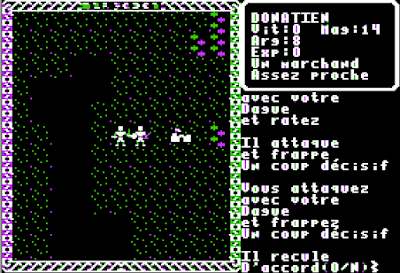 |
| After I strike a decisive blow, the thief tries to back off. |
Still, combat was pretty hard, so after I’d won a few battles, I went into the town to check out some of the other options. Fully healing takes only a single gold piece at the Temple of Eros, which is nice. But equally beneficial are temporary boosts to each attribute that the temple offers for 20 gold pieces. If you load up with a couple of these (strength, dexterity, or vitality) before heading out, they greatly improve your chances in combat. You can get similar boosts from potions at the alchemist’s, only these you can carry with you and use in the field at the appropriate times. Finally, when you earn a few hundred experience points, you can spend them at the guild for permanent attribute increases. As you buy these, the game re-calculates the derived statistics. All told, it’s a tight, satisfying combination of character development and economy.
Even better, you can pay experience points to change classes. If you decide you want some magic in your life, that’s only 100 or 200 experience points away.
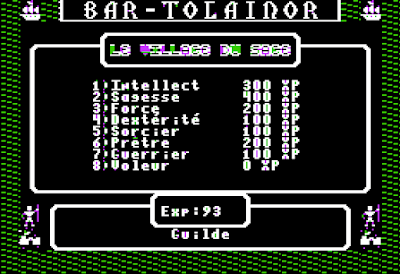 |
| In 7 more experience points, I can increase my dexterity or change to a sorcerer or warrior class. |
I spent a couple hours fighting, building my fortune, and buying attribute increases as I tried to count the number of tiles in the land. Once I was loaded up on buffs, I headed off on the first quest lead, which I got from the inn. When I first checked into the inn, I saw three options with escalating values, and I assumed they were different quality rooms. Later, thinking I was buying a room for the night, I chose the first option. It turns out that the three options are subjects about which you’re bribing the bartender. For the subject “Ered-Morglin,” I learned:
It is a cyclops who directs the mines of Ered-Morglin. His talents as a blacksmith allowed him to make powerful relationships. However, the wise men of Bar-Tolainor suspect him of having allied with Beltrik. They promise their eternal gratitude to whoever brings them the head of the one-eyed monster.
I explored around until I found the dungeon of Ered-Morglin. Dungeons are top-down in this game, not first-person. Otherwise, they’re like exploring cities in the early Ultimas. Some enemies appear out of nowhere, just like in the wilderness, but others are in fixed locations. Secret doors are clued with little breaks in the walls, just as in Ultima IV.
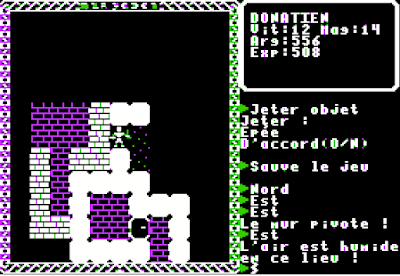 |
| Note the secret door in the wall to my left. |
If there’s any way so far in which Muryaden lives up to its backstory and intent, I suppose it’s in the room descriptions that you receive while exploring the dungeon, although none of them are as bawdy as the backstory.
- You see a convergent layer of manticore excrement and blood.
- The remains of an orgy: the bowels of elves marinated in the blood of gnomes.
- You see a statue of Grumsh impaling an elf on a lance!
The combats in the dungeon wore down my vitality to the point that I couldn’t really take any damage or I’d have to reload, but I stubbornly kept at it until I found the cyclops and managed to kill him and take his head. I also found a key beyond him that must be important somewhere. There were only two treasure chests in the dungeon; both had a modest amount of gold.
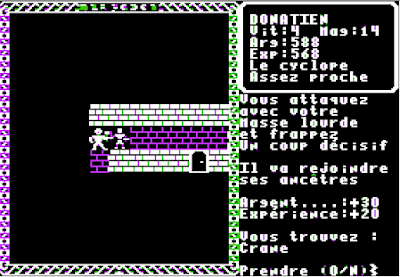 |
| I have slain the cyclops and can now take his head. |
I triumphantly carried the cyclops head to the city of Bar-Tolainor. I visited the sage, who I don’t think gave me any reward at all unless you consider a new quest a reward:
My premature ejaculation is a sign! You are the chosen one. Your destiny is to fight the libidinous Beltrik whose secret I will reveal to you. In fact Mithgul did not perish when his complex exploded. He and the demon he had summoned suffered the full effect of the brunettes. Thus they have fornicated for centuries until the effect of the malefice dissipates. The demon then became familiar with Mithgul. The archmage is daring and perverted by his experience. Had lost much of his knowledge. He renamed himself Beltrik and dedicated himself to the forces of chaos. Here is a letter of introduction to the king. Valdrin will no doubt offer you a substantial reward.
Meanwhile, from the other two auberge options back in Bar-Calenlad, I learn:
- In Térégroth resides the Matriarch and her supporters. All are fanatical worshipers of Vaprak and pay bloody tributes to him. The ritual sacrifices organized in honor of the Destroyer are also cannibal orgies, where sins of flesh and money are indiscriminately consumed. This citadel has never, until now, been threatened, thanks to its high walls and its mithril door. Yet each door has its own key; that of Térégroth could also open the Matriarch’s chastity belt.
- The lair of Beltrik, the lustful wizard, remains unknown to this day. The sages, however, called it Coron Raugul and claimed it was protected by an invisibility spell. They also say that it is guarded by a nigh-invincible golem. This sentinel, however, has a weak point: its diarrhea, which it can only wipe with the sheets of a spellbook cursed three times. This book is the Pnakoticus Qhultis of Count Bren-lette, also called P. Q. The golem will gladly let pass anyone who offers him a roll of this precious paper. [The joke here is that P. Q. in French is the abbreviation for toilet paper.]
So few golems in ricaine RPGs are cursed with diarrhea, and I just want to say I think it’s what’s been missing.
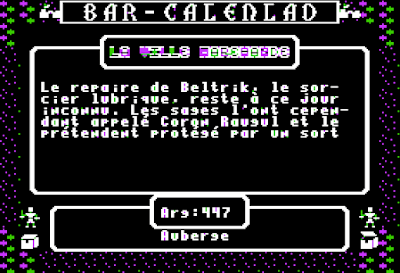 |
| Getting a clue on the final quest. |
Unfortunately, I ran into a technical problem that’s going to prevent me from continuing with the game without starting over. While I was exploring Ered-Morglin, testing the walls for secret doors, I found an illusory wall that let me out of the dungeon, onto a random part of the map terrain. I figured that it was a secret “back door.” By walking one space back the way I’d come, I returned to the dungeon. I didn’t think anything of it, and I finished the dungeon. Because it was closer the cyclops than the main entry, I used the “back door” to get out. I was able to turn in the quest without any problem.
I soon realized that the “back door” wasn’t that at all but a game corruption. The game still thinks I’m in the dungeon, and if I wander on the map into any coordinates that the dungeon level covers, I suddenly find myself back in the dungeon. Since there are towns and dungeons, and I think even the castle in that coverage area, that’s no good. I need to be able to enter those areas on the main map without warping to the dungeon. Unfortunately, trying to exit from the dungeon the regular way just freezes the game. I thought maybe if I found a second dungeon and entered and exited, it would work, but those aren’t on the accessible part of the map.
 |
| As far as I can get. |
Fortunately, I don’t need to win it myself because “Deckard’s” web page describes what happens: The player takes the letter of introduction from the sage to King Valdrin of Gondarnost, who steps out of his harem long enough to give the player a new quest. Valdrin’s daughter was kidnapped by Beltrik, used as a “toy” for a while, then given to the Matriarch of Térégroth. Valdrin wants her back so he can marry her to the troll king, Bortrog, to seal an alliance between the cities. Valdrin also suggests that Bortrog would reward the character for killing the Matriarch.
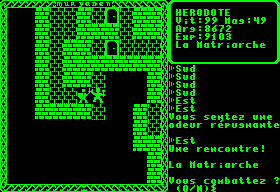 |
| Defeating the Matriarch. Don’t ask me why the screen shots are in this color. |
The key found in Ered-Morglin turns out to be the key to Térégroth and the Matriarch’s chastity belt. The player goes to Térégroth, kills the Matriarch, recovers the chastity belt as proof, and frees the princess. The game makes a point of noting that the princess’s cell smells of urine, because that was important. The princess appears in your inventory, and from then on you can “use” her like any object for things I’ll leave to your imagination.
You return the princess to Valdrin, who does marry her to Bortrog. Bortrog rewards you for the Matriarch’s belt. But he doesn’t think his new bride is sexy enough, so he wants Beltrik’s beauty stone. The scroll found in Térégroth turns out to be the key to finding the invisible city of Coron Raugul. It’s also the item necessary to give to the golem to let you pass.
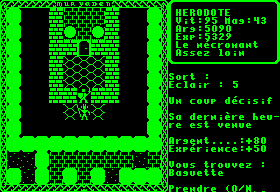 |
| The player confronts Beltrik. |
In Coron Raugul, the player defeats Beltrik and his pet demon and finds the stone, which turns out to be called “Muryaden” for whatever reason. Bringing it back to the troll king results in a congratulatory screen in which the troll king gives you the stone (after he’s done using it). His mage attunes the stone so that it will serve like a permanent Potion of Healing. The player can continue killing monsters and building his statistics if he wants.
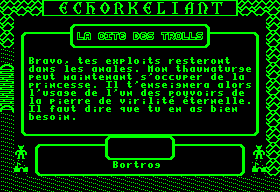 |
| The winning screen. |
It will surprise no one that the plot elements of Muryaden aren’t my favorite parts of the game. The authors’ complaints about a certain lack of grit in the typical RPG of the period are not wrong, but the solution would lie in the future, with more complex characters, more nuanced plots, an in general better writing, not in the toilet humor of a couple of teenagers. At the same time, though, there are plenty of elements of the game that I don’t mind. I like the low-key nature of the quests. I like that the main character is more of a mercenary than a hero, and that none of his employers are sparkling clean. I like that the developers kept it small and short, understanding that they didn’t have the mechanics for an epic game. And as I said above, character development and combat are pretty tight. It earns a 24 on my GIMLET, doing best in character development, combat, economy, and gameplay (3s). That’s not a horrible score for an independent Ultima clone.
Elrik and Deckard continued their partnership with Muryaden Livre 2 in 1991. I can only hope that the extra two years matured their storytelling while preserving their inventiveness. I’m not sure what happened to them after that. “Elrik” was a pseudonym for Eric Bertrand, and there is a programmer of that name with numerous credits on Ubisoft titles, but his ludography doesn’t pick up until 2006, or 17 years after Muryaden, and I’m not sure if it’s the same developer. “Deckard” seems to be a Jean-Marc Boutillon; from an interview he gave, I don’t get the impression that he worked on anything more than these two titles.
We are going to move on to Abandoned Places: A Time for Heroes after another Britannian episode.
Original URL: http://crpgaddict.blogspot.com/2020/05/game-365-muryaden-1989.html
